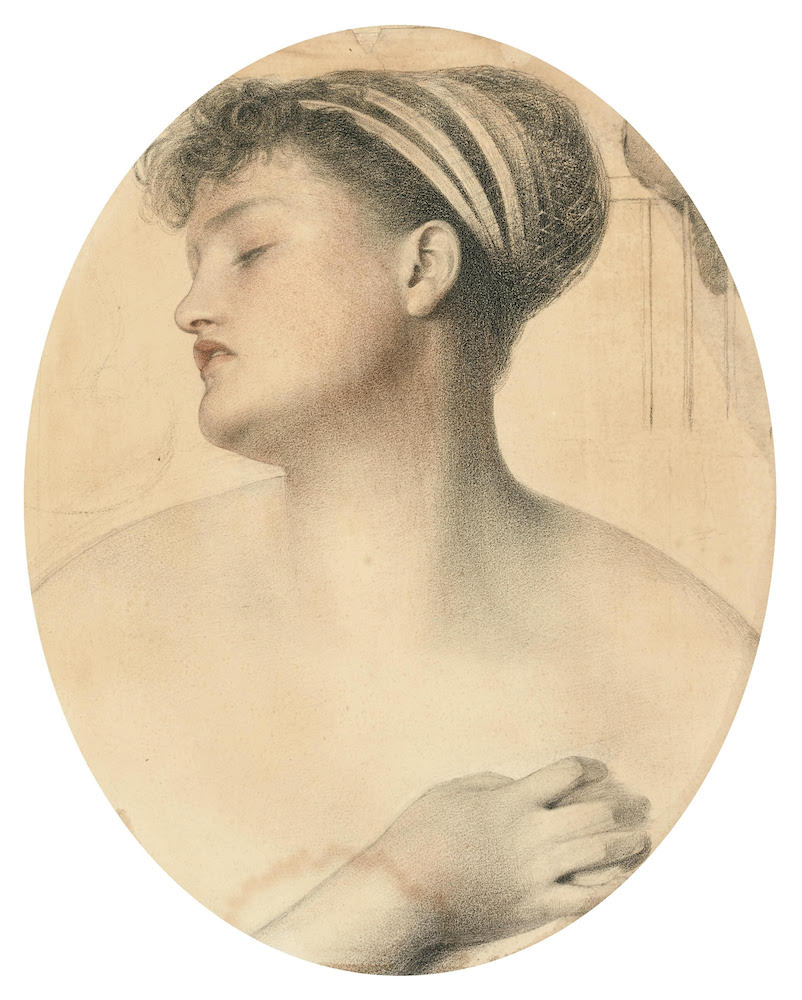
Study for “Girl with Doves” by Anthony Frederick Augustus Sandys (1829-1904). c. 1867. Pencil and black and red chalks. 16.5 x 22.5 inches. 15 3/4 x 21 1/2 inches (40.1 x 54.6 cm) – sight. Private collection: image courtesy of the author.

Study for Girl with Doves. c.1867. Pencil and black and red chalks; 17 x 13 1/2 inches (43 x 34 cm) – oval. Private collection. Image courtesy of Sotheby's.
These two sensual drawings portray a young woman facing to the left with her eyes partially closed in one and totally closed in the other. The model for these drawing was Mary Emma Jones and these are two of Sandys's earliest representations of her. Mary was one of three sisters famous as Pre-Raphaelite models in the 1860s, the other two sisters being Anne Maria "Augusta" Jones and Emelie Eyre "Milly" Jones.
Mary Emma Jones was born in 1845 in Hull, the daughter of a customs inspector at the docks. Her family moved to London around 1862. The sisters modelled for avant-garde artists including D.G. Rossetti, Edward Burne-Jones, James McNeill Whistler, Frederic Leighton, Albert Moore, Edward Poynter, Simeon Solomon and Henry Holiday. Mary was also an actress, whose theatrical name was Miss Clive, but her acting career was not particularly successful. She first met Sandys in 1862 in Norwich where she modelled for him for his painting Mary Magdalene. Mary later became Sandys' mistress around the time these two drawings were executed. She lived with him as his common-law wife and bore him twelve children, seven daughters and two sons of which survived infancy. Their first child was born in 1867 and the last in 1886. She modelled for him for many paintings and drawings over the years. She was also the likely model for his most erotic print, Danaë in the Brazen Chamber, of 1866.
These two drawings of Study for Girl with Doves may be preliminary studies for a projected Lucrezia Borgia painting which is untraced, and was most probably never completed. A dove in its entirety can be seen in the upper right of the rectangular drawing while in the oval drawing, which was likely cut down at some point, the feathers of a dove can just be visualized in the upper right. The doves are included in the drawing because in Sandys's version of the story Lucrezia was testing out poison on pet doves before administering it to her intended victim. Correspondence between Sandys and D. G. Rossetti in May and June of 1869 supports this theory. Sandys described his idea for the picture in a letter to Rossetti dated 15 May 1869: "I was about to paint two pictures of Lucretia [sic] Borgia – one standing – the other sitting. The motive in both pictures being the same - Lucretia in her chamber - testing her poison on one of two pet turtle doves - one lying dead at her feet - the other sitting up behind her... My picture was suggested entirely by the little girl [his pet-name for Mary Emma Jones]" (letter, Library of Congress, qtd. Elzea, 192).
This design for Lucrezia Borgia was one of those cited by Rossetti, the other being Mary Magdalene, when he accused Sandys of plagiarism in 1869. The accusation that Sandys was stealing his ideas for pictures caused a serious rift in the friendship between the two artists. Although Sandys's picture likely would not have not have resembled Rossetti's anyway, Sandys abandoned his Lucretia Borgia picture, probably out of pique. Sandys was a person who was always quick to take offence. The friendship between the two artists was later re-established.
Bibliography
Elzea, Betty. Frederick Sandys 1829-1904. A Catalogue Raisonné. Woodbridge, Suffolk: The Antique Collectors' Club Ltd., 2001, cat. 2.A.130, 199.
Library of Congress, Manuscript Division. Pennell-Whistler Collection, Box 23. Sandys.
Maas, Rupert. Pre-Raphaelitism. London: Maas Gallery, 2013, cat. 4.
Victorian, Pre-Raphaelite & British Impressionist Art. London: Sotheby's (14 July 2016): lot 13, 21.
The original image on this page came from the Maas Gallery, London, which has most generously given its permission to use in the Victorian Web information, images, and text from its catalogues. We are most grateful for this valuable resource. Readers should consult the gallery website to obtain information about recent exhibitions and to order their catalogues. [GPL and JB]
Created 27 April 2013
Last modified 16 August 2025